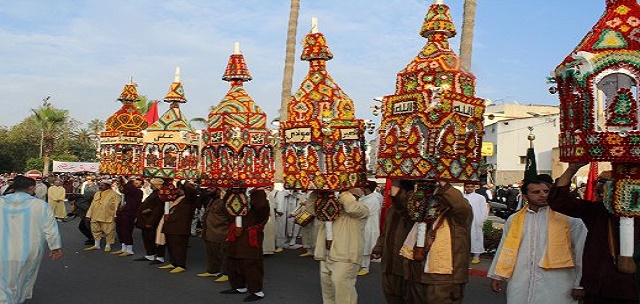Procession of candles

The moussem of the candles of Moulay Abdallah Benhassoun, held in Sale, under the patronage of His Majesty King Mohammed VI and in commemoration of the feast of Aid Al Mawlid Annabaoui, is an ancestral tradition and also testifies to the Moroccans’ Islamic and Intangible Cultural Heritage. The organization of this event aims at intellectual enrichment, animation but also to root the love of God and the prophet in the minds of Muslims and to participate in the education of the younger generations.
Indeed, the procession of candles dates back to the reign of the Saadi Dynasty under Ahmed El Mansour Addahbi (1578-1603), who was very impressed, during his stay in Turkey with his brother Abdelmalek Essaadi, by the festivities marking the Aid Al Mawlid Annabaoui, especially by the procession of tapers. He decided to consecrate and promote Ottoman tradition of Istanbul.
The first celebration of this procession in several Moroccan cities dates back to the year 986 of the Hegira.
The city of Fez made painted oriflammes, Marrakech in paper and Salé in wax and it is in this last city that this tradition persists creating on the shore of Bouregreg, this prestigious and picturesque Moussem of the candles of Sidi Abdellah Benhassoun, whom the Generations have taken turns to make it revive every year.
The Sultan Ahmed El Mansour Addahbi will charge the Sufi Sidi Abdellah Benhassoun (1515-1604) to ensure the smooth unfolding of this moussem, later become the prerogative of his descendants.
Born in Fes in 920 h / 1515, Sidi Abdellah Benhassoun Abu Mohamed Abdellah Ben Hassan Alkhaldi Al Hassani Al-Idrissi, better known as Benhassoun, was a prominent figure of his time. He had tapped and refined his knowledge among the great oulema of Fez, such as Abdelouhad Al Ouencharissi and Abderrahmane Doukkali, two Imams and preachers of Qaraouyin, or Abdallah Habti, sheikh of the Zaouia of Jbel Lach’hab, near Chefchaouen.
In the year 990 of the Hegira, the city of Salé had organized its first Moussem of the kind, with a procession of candles in shimmering colors, whose design and realization by the master craftsmen require finesse and originality.
Over the centuries, several families have succeeded in the manufacture of these candles, the most famous of which are those of Oubia since 450, the El Mir family, El Hoceini and Lamrnissi and the Chekroun family.
Currently, this mission is entrusted to the Belakbir family. One month a year, the maalems lock themselves in their workshop to work day and night. They make, with wooden molds, square, lozenge, blue, red, green, yellow, white and black flowers which, when glued together, will form a mosaic on wooden structures representing minarets.
The moussem of the candles begins with the procession, organized after the prayer of Al Asr, on the eve of Aid Al Mawlid Annabaoui.
At the head of the procession are the descendants of the mystic Sidi Abdellah Benhassoun, followed by the oulema and preachers and then come the candle bearers and the people.
Each year this procession crosses the main arteries of the city of Salé, passing through the Achouhada (Bab Bouhaja) square, to the mausoleum of Sidi Abdellah Benhassoun. This procession is followed in the evening by festivities marked in particular by the holding of a feast to which are invited all the participants and the needy families, the execution of the “dance of the candle” and the interpretation of songs of the music Andalusian before proceeding to the ceremony of the lighting of the candles which will be accompanied by songs of samaa and madih.
Also on the agenda of the event is the organization of conferences, book exhibitions, workshops, Arabic calligraphy exhibitions, and book signing ceremonies, theater performances, visits to historic sites and monuments, and circumcision operations of orphaned children.
